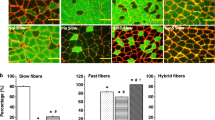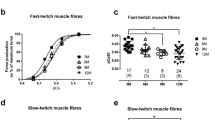Abstract
In newborn Wistar rats the load on the soleus muscle was reduced by removing the tibialis anterior (TA) and extensor digitorum longus (EDL) muscles. Eighteen days later the soleus muscles were removed from both the operated and control legs and examined physiologically and histologically. The time course of twitch contraction of the soleus on the operated side was not significantly different from that of control muscles, but the muscles developed less tension. The decreased tension was consistent with a smaller number of muscle fibres. Histochemical and immunocytochemical examination showed that in the operated muscle, fewer fibres reacted with an antibody against slow myosin, while the number of fibres that reacted for alkali-preincubated ATPase, indicative of neonatal or adult fast myosin, was increased. Some fibres expressed both types of myosin. These findings suggest that a reduced load delays the phenotypic expression of slow myosin isoform in the developing soleus muscle.
Similar content being viewed by others
References
Booth FW, Seider MJ, Hugman GR (1980) Effects of disuse by limb immobilization on different muscle fiber types. In: Pette D (ed) Plasticity of muscle. de Gruyter, Berlin New York pp 373–383
Brooke MH, Kaiser KK (1969) Some comments on the histochemical characterization of muscle adenosine triphosphatase. J Histochem Cytochem 17:431–432
Dhoot GK, Dransfield I, Grand RJA, Perry SV (1986) Distribution of isoforms of myofibrillar proteins in myoid cells of thymus. J Muscle Res Cell Motil 7:351–360
Goldspink DF, Goldspink G (1986) The role of passive stretch in retarding muscle atrophy. In: Nix WA, Vrbová G (eds) Electrical stimulation and neuromuscular disorders. Springer Berlin Heidelberg New York, pp 91–100
Gollvik L, Kellerth O-J, Ulfhake B (1988) The effects of tenotomy and overload on the postnatal development of muscle fibre histochemistry in the cat triceps surae. Acta Physiol Scand 132:353–362
Hnik P, Vejsada R, Kasicki S (1988) Electromyography in chronic animal experiments. CSAV, Prague
Kugelberg E (1976) Adaptive transformation of rat soleus motor units during growth. J Neurol Sci 27:269–289
Nachlas MM, Tsou KC, DeSouza E, Cheng CH, Seligman AM (1957) Cytochemical demonstration of succinic dehydrogenase by the use of a new p-Nitrophenyl substituted ditetrazole. J Histochem Cytochem 5:420–436
Navarrete R, Vrbová G (1983) Changes of activity patterns in slow and fast muscles during postnatal development. Dev Brain Res 8:11–19
Pette D. Vrbová G (1985) Invited review: Neural control of phenotypic expression in mammalian muscle fibers. Muscle Nerve 8:676–689
Round JM, Mathews Y, Jones DA (1980) A quick simple and reliable histochemical method for ATPase in human muscle preparations. Histochem J 12:707–710
Vrbová G (1963) The effect of motoneurone activity on the speed of contraction of striated muscle. J Physiol 109:513–526
Whelan RG, Sell SM, Butler-Browne GS, Schwartz K, Bouveret P, Pinset-Härrström I (1981) Three myosin heavy-chain isozymes appear sequentially in rat muscle development. Nature 292:805–809
Author information
Authors and Affiliations
Rights and permissions
About this article
Cite this article
Lowrie, M.B., More, A.F.K. & Vrbová, G. The effect of load on the phenotype of the developing rat soleus muscle. Pflügers Arch 415, 204–208 (1989). https://doi.org/10.1007/BF00370593
Received:
Revised:
Accepted:
Issue Date:
DOI: https://doi.org/10.1007/BF00370593




